The parent asteroid of December's Geminid meteor shower, 3200 Phaethon, is about to make a historically close flyby. Get ready to watch it race across the sky.
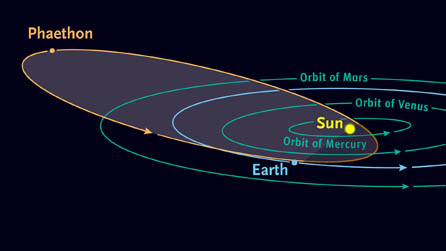
Sky & Telescope diagram
We have a fantastic opportunity to see a unique asteroid brighter than it's ever been observed. 3200 Phaethon (FAY-eh-thon), the size of a rural hamlet, will pass within 10.3 million kilometers from Earth at 6 p.m. Eastern Time (23:00 UT) on December 16th. Just before closest approach, it will reach magnitude 10.7, bright enough to track in a 3-inch telescope. And I do mean track. Hold onto your eyepiece! This thing will be scooting along at up 15° per day or 38″a minute (about the distance between Albireo and its companion star) — fast enough to cross the field of view like a slow-moving satellite.
Whenever I see an asteroid or comet move in real time, I'm reminded of a particular 10-km-wide rock that slammed into the Yucatan 65 million years ago and led to the extinction of the dinosaurs. To a T. rex with a telescope, the coming nemesis would have looked like an innocent pinprick of light the night before, inching across the stars just like Phaethon will for us. Only in this instance, we needn't worry about an impact. While classified as a potentially hazardous asteroid, a look ahead shows that Phaeton will keep a safe distance for at least the next four hundred years.

Tom Ruen, with additions by the author
Phaethon distinguishes itself in other ways. It comes closer to the Sun than any other named asteroid, with a perihelion distance of 0.14 AU, or less than half that of Mercury. If lead melts on the innermost planet, where the temperature reaches 800°F (427°C), Phaethon's got it beat by a mile. Its scorched surface tops out around 1200°F (627°C), hot enough for lead to flow like water and aluminum to turn to putty.
Getting roasted by the Sun every 524 days explains Phaethon's other claim to fame as the parent of the Geminid meteor shower. Shortly after it was discovered on October 11, 1983, with the orbiting Infrared Astronomical Telescope (IRAS), American astronomer and comet researcher Fred Whipple noticed that Phaethon's orbit matched that of the Geminids, clinching it as the shower's source.
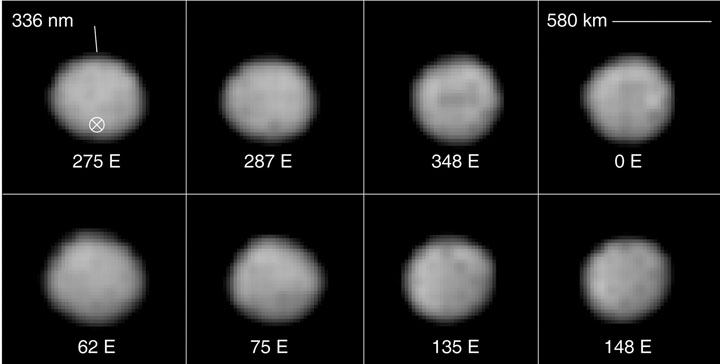
B. E. Schmidt et. all / NASA / ESA
Most meteor showers originate with comets. When a comet gets near the Sun, solar heating vaporizes dust-rich ice from its nucleus, and the push of sunlight (radiation pressure) blows it back to form a coma and tail. The ejected material forms a trail or stream along the comet's orbit; when the Earth slices through it, the dust slams into the atmosphere and vaporizes, particle by particle, in a meteor shower.
So how do you get dust from an asteroid? An early hypothesis, now discarded, posited that Phaethon might have ice beneath its surface that vaporizes around the time of perihelion. Sounds plausible, but measurements show the asteroid gets too hot for ice to survive either inside or out. Still, you might get blood from a turnip if that turnip is composed of carbonaceous (carbon- and water-rich) minerals like our friend 3200 Phaethon and heated to a temperature high enough to cause the material to break down, crack, and crumble into dust.
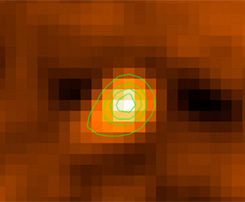
NASA
If Phaethon was once a traditional comet, it is no longer. These days, it's considered a rock comet. a rare type of object that outgasses rock particles instead of ice.
When you pour boiling water on cold glass, the glass shatters from thermal shock. Similarly, extreme solar heating at the time of perihelion causes rapid expansion of Phaethon's crustal rocks. They fracture and release dust that's carried away by the radiation pressure of sunlight. Experiments have shown that the dust particles are about a millimeter across, approximately the size of the Geminids.
For a brief time during the 2009 perihelion, astronomers recorded a surprise doubling in the asteroid's brightness, likely caused by one of these gritty outbursts. Yet questions remain. A meteor shower requires constant nourishment from its parent to put on a show year after year, decade after decade. Astronomers estimate that to maintain a steady supply of meteor dust, Phaethon would have to flare 10 times as often as observed. Does it shed its skin out of sight, when its in the harsh glare of perihelic sunlight?
Whatever's going on, we're going to have a bang-up December. Not only will Phaethon be brighter than ever, but its appearance coincides with the December 13–14 peak of the annual Geminid meteor shower — a rare pairing! We'll have more on the Geminids next week. For now, our job will be to find and follow this exciting asteroid.
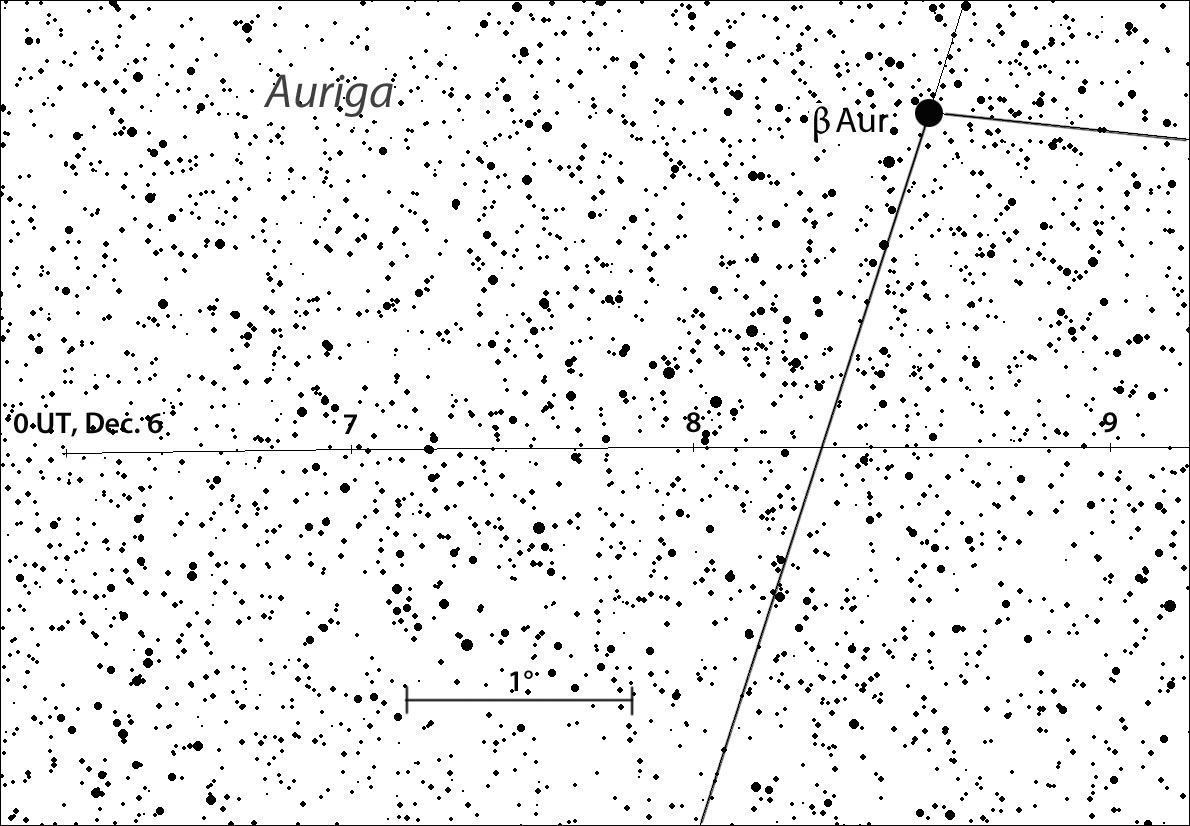
SkyMap
From November 29th through December 3rd, Phaethon brightens from magnitude 14 to 13, but does so handicapped by the glare of the nearly full Moon. Luckily, the Moon's out of the way starting on the 5th, when Phaethon will have reached magnitude 12.6 and be within range of a 6-inch or larger telescope. When brightest from December 12–15, it shines between magnitude 10.7 and 10.9. Because we're seeing the asteroid in full or nearly full phase, Phaethon stays relatively bright for many nights prior and up to closest approach. Soon after, it fades as its phase from our perspective thins to a crescent. By December 19th, it drops back to 13th magnitude and then to 15th magnitude on December 21st.
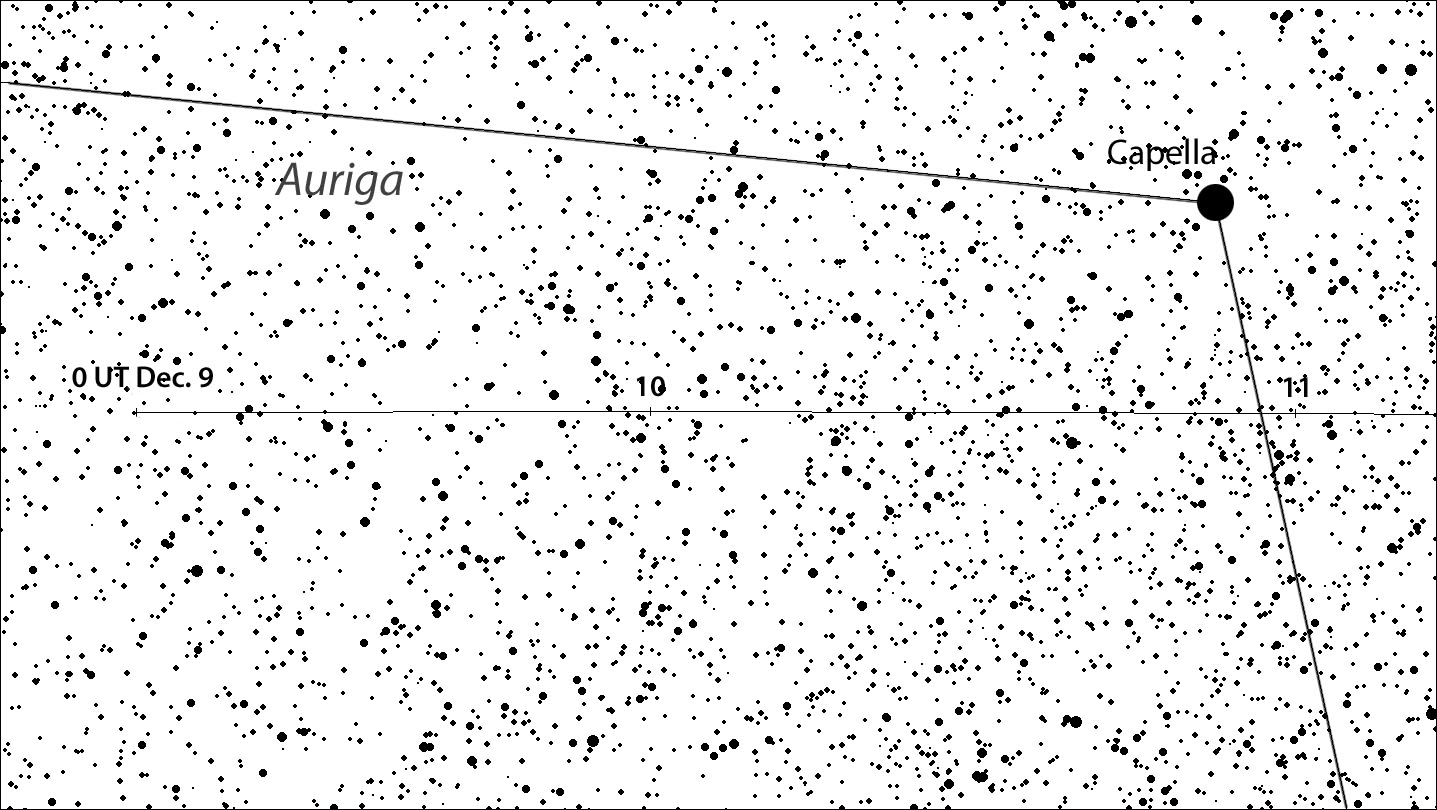
SkyMap
Phaethon spins once on its axis every 3.6 hours with a +0.4-magnitude variation in brightness that patient observers may be able to detect. Visual observers and astrophotographers should also be on the lookout for brightness flares or the potential appearance of a coma.
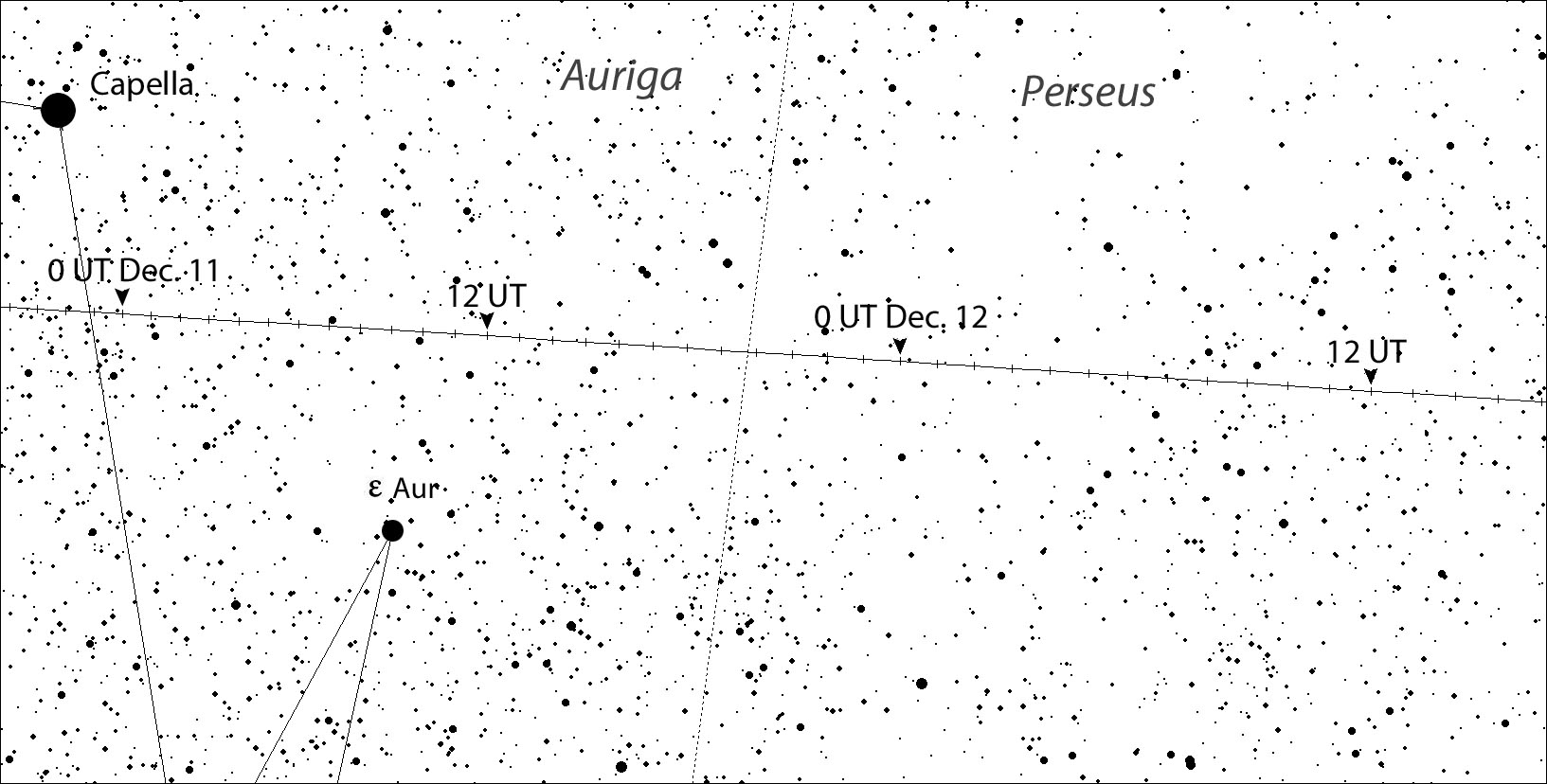
SkyMap
Our maps will take you through December 17th. I apologize for their number, but Phaethon covers a lot of ground through a star-rich Milky Way, making detailed maps a necessity. I encourage you to create your own personalized charts, easy to do with sky-mapping programs like Stellarium, MegaStar, and Starry Night. For step-by-step instructions, scroll to the end of this earlier blog.
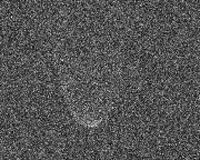
Arecibo / Cornell
NASA's 70-meter Goldstone dish will make good use of this apparition to obtain the clearest pictures yet showing Phaethon's shape and surface features by bouncing radio waves off the object and constructing images based on return echoes. Observations are scheduled for 10 days between December 11–21.
If you don't own a telescope and still want a peek at the asteroid, watch it live on Gianluca Masi's Virtual Telescope Project website at these times: December 15th from Arizona starting at 09:00 UT and December 16th from Italy starting at 20:00 UT.
Try to catch Phaethon now because it won't get this bright again until December 2093, when it will pass within 0.02 AU of Earth and brighten to magnitude 9.4.
Additional charts for tracking Phaethon through December 17th:
- December 12–13
- December 13–14
- December 14–16 (color, B&W)
- December 15–17 (color, B&W)
 30
30









Comments
Russ
December 1, 2017 at 12:59 am
Hi Bob,
This looks to be an interesting apparition to view. Strangely when I use SkySafari on my iPad to plot the course of 3200 Phaethon, I get a path that is significantly different that what is shown on the charts you have supplied. I see Phaethon going right down the middle of the triangle in Triangulum, between Beta and Gamma Triangulum, on November 30th. Your color chart for December 14-16 shows the path considerably north of mine and some 15 days after what I see in SkySafari. I made sure to update the Minor Planet Elements in SkySafari and still get the same course. Now I'm using an iPad-1 with iOS 5.1.1 - yeah, it is ancient by computer standards. So it's possible that with my equipment the software is making an error in its plot. But I haven't found that to be the case prior to this. It is also possible that I've made an error in the use of SkySafari. If that is so, it has escaped my notice.
But this is just a "head-up" to check results. What are others finding in this regard?
In any case Bob, thanks for the interesting article. I hope it all pans out for us.
Best regards,
Russ
You must be logged in to post a comment.
Bob KingPost Author
December 1, 2017 at 10:00 am
Hi Russ,
That's a big difference and it puzzles me. I created the first few charts using SkyMap after grabbing the latest elements at http://www.minorplanetcenter.net/iau/MPEph/MPEph.html
The final set (color and BW) were created by the staff at Sky & Telescope. Both the SkyMap and S&T charts match. The wide-field chart showing the phases is from a third source and also shows the asteroid passing well north of Triangulum. Did you get your elements from the MPC link above?
You must be logged in to post a comment.
December 25, 2017 at 10:18 am
Just my 2 cents. Parallax might be the answer. It was first pointed out to me by NASA's NEO manager when I learned how to use the Horizons' database.
Near earth objects (NEO's) are particularly close, as compared to stars. It is significant to record your telescopes position, into an ephemeris generator, before getting accurate results.
Having said that, one persons location in an application, like SkyMap (which I've never used - so take the comment with a grain of salt) will generate different chart sets.
Clearly, if you have telescopes that are separated by wide margins of real estate, say, Pennsylvania, and North Carolina - the effect is noticeable. One one occasion, while learning, while successfully recording J2012 TC4 from La Serena, I completely muffed up my results from Australia.
You must be logged in to post a comment.
Russ
December 1, 2017 at 3:52 pm
That is puzzling, Bob. But I'm pleased that your 3 sources agree on the path and timing of Phaethon's pass by Earth. I'm not sure where SkySafari gets the elements it uses for solar system bodies. One would assume it is from some of the same sources you used. So I won't be able to rely on SkySafari for this asteroid. Usually I connect SkySafari wirelessly to my Losmandy G-11 to do a go-to an object selected on the iPad. But in this case I'll use your maps to determine its location relative to a prominent background star. Then I'll have the mount go-to the location (RA & Dec) of that star. Should have Phaethon in the FOV. Looks like it might be best for me to purchase another copy of SkySafari to run on my iPad-Mini, which has the current iOS. That old iPad-1 is getting close to being a museum piece. Up to now it has worked flawlessly for telescope control and general information.
Thanks for checking on this, Bob. I hope we can all enjoy this event.
You must be logged in to post a comment.
Michael Sterling
December 1, 2017 at 4:09 pm
FWIW, I checked this morning on Starry Night and positions match the charts Bob generated.
When I tried to observe 2012 TC4, Starry Night was way off (like 25 degrees) so I just used Horizons minute by minute positions, aimed scope to a relatively bright star in the predicted path (manually plotted in Uranometria 2000) and at the appointed minute, sure enough, the asteroid drifted through.
So my guess is it depends on the distance from the earth for accuracy on the software program.
You must be logged in to post a comment.
Karl
December 1, 2017 at 6:00 pm
I think to a T. rex with a telescope, the coming nemesis would have looked like an innocent pinprick of light the night before, just like Phaethon will for us.
Except NOT inching across the stars, just a little brighter each night... maybe hard to notice. OTOH, if it was a comet the last few nights would have been spectacular.
You must be logged in to post a comment.
Russ
December 2, 2017 at 3:22 am
I updated the minor planet elements last night (November 30, 2017) on SkySafari and checked them against what is given in Bob's link to Minor Planet Center. I was able to get matches for all of Phaethon's orbital elements EXCEPT for orbital period. SkySafari gives 523.50 days. Now I'm not totally sure what all the column headings are. But for Phaethon NONE of the presented orbital elements gives that number. The column labelled "Peri." which I assume means period gives a value of 322.2 (days?).
So it appears that SkySafari downloaded an incorrect period for Phaethon. In SkySafari I did another Update Minor Body Orbit Data tonight (December 2nd) and got the same elements. So SkySafari 3.8.5 is getting an erroneous orbital period for Phaethon from somewhere.
That's not a good outcome. But at least it shows where then problem lies.
You must be logged in to post a comment.
Kevin Heider
December 2, 2017 at 9:06 pm
The argument of perihelion is 322.1° at epoch 2017-Sep-04. The orbital period is 523 days (1.43 years).
You must be logged in to post a comment.
Russ
December 4, 2017 at 12:24 am
Thanks, Kevin for the clarification. So the problem was some unknown setting in SkySafari. After resetting to default settings, it plots Phaethon's path correctly.
You must be logged in to post a comment.
December 1, 2017 at 6:25 pm
Russ: I just checked the asteroid position on Sky Safari Pro version 5.0.1 running on an iPad with iOS 8.3 (itself a dinosaur, but perhaps not as antediluvian as yours!) and it matched Bob's charts spot-on. Sky Safari 3.8.5 on the same iPad is off a ways because that version of SS can't update the minor planet orbit data anymore, but even it doesn't run the asteroid through Triangulum. I'm guessing you've got some other setting awry, although I can't imagine what would cause it to be that far off. Worth poking around a bit in the program, though, to see if you can puzzle it out.
You must be logged in to post a comment.
December 1, 2017 at 6:33 pm
Hey, I take that back about SS version 3.8.5 not being able to update its minor planet orbit data! I just now tried it again and it succeeded this time. The asteroid path matches Bob's charts in this version now, too.
You must be logged in to post a comment.
Shawn Quinn
December 5, 2017 at 6:32 am
I have Sky Safari 5 Pro for the Mac. There are two entries for 3200 Phaethon. Asteroid 2014 JO25 from last April also had two entries. I received this from the vendor: "Currently I'm seeing the asteroid in Virgo for both entries. There is a complex technical reason why we are showing two entries for this asteroid. In this case the second entry has the most recent orbital elements and is much more accurate. Check the Info for the entry and scroll to the bottom. The "Orbit Epoch" for the correct one should be Feb 16th, 2017." I'm not sure if this is also true for 3200 Phaethon.
You must be logged in to post a comment.
Bob KingPost Author
December 5, 2017 at 9:30 am
Hi Shawn,
It's unfortunate that the MPC doesn't include Sky Safari Pro at this site: http://www.minorplanetcenter.net/iau/MPEph/MPEph.html
But if you have one of the other programs shown and want to create your own maps, type the name 3200 Phaethon in the open box, click "Get Ephemerides" and you'll get a file you can drop into the program for easy chart-making.
You must be logged in to post a comment.
Shawn Quinn
December 6, 2017 at 6:12 am
Thanks Bob!
Shawn
You must be logged in to post a comment.
Glenn-Miller
December 10, 2017 at 8:54 am
Please correct me if I'm wrong, but isn't "15 degrees per day" equal to 0.625 arcminutes per minute (not "1.6 arc minutes a minute")? This would be more consistent with maxixmum "Sky Motion" value of 38.59 arcseconds per minute on the MPEC ephemeris web site. If so, this will not be a fast-moving event.
Thanks for the article and advice!
You must be logged in to post a comment.
Bob KingPost Author
December 10, 2017 at 10:55 am
Hi Glenn,
Thanks for pointing out my boo-boo. Now corrected. Since 38" a minute is about equal to one "Albireo separation" a minute, it will still be moving fast enough to see move in real time.
You must be logged in to post a comment.
Bob KingPost Author
December 12, 2017 at 2:05 pm
Hi everyone,
Just to update. 3200 Phaethon is now bright at around magnitude 11 and easy to see in smaller instruments. I've been tracking it the past two nights and was able to see it move a-l-m-o-s-t in real time when using a magnification of 242x. In the next couple nights, it will quickly pick up speed.
You must be logged in to post a comment.
Joe Stieber
December 13, 2017 at 9:36 pm
Indeed. I spotted (3200) Phaethon at 2:40 am EST this morning, 13-Dec-2017, from semi-suburban New Jersey, a few miles from the intersection of 40N-75W, with my 85 mm spotting scope at 60X. I used my own custom finder charts generated with SkyTools to find Phaethon, then confirmed it by its motion (not in real time). Looking at Bob's chart for December 12-13, Phaethon's position that I observed is accurately plotted. BTW, I've been using the 85 mm spotter recently out of necessity rather than some sort of small-aperture challenge.
You must be logged in to post a comment.
Bob KingPost Author
December 14, 2017 at 11:39 am
Hi again Joe,
Good to know our charts agreed and cool you spotted Phaethon in a small scope, proving you sometimes don't need fancy equipment to see amazing sky sights. I should have observed it last night when it was really moving fast, but instead gave myself over to the Geminids.
You must be logged in to post a comment.
MarkInSocorro
December 14, 2017 at 4:34 pm
This is a very worthwhile observing project. I enjoyed tracking the parent body of the Geminids on the same night, 12/13, I watched the Geminids. The finder chart provided in this article was spot on. I used a 10" dob at 70x. I was easily able to track the motion of 3200 Phaethon, plenty of field stars with dark New Mexico skies and a 10" dob. I saw a few dozen Geminids between 9PM and midnight. Notable were 2 bright ones that left short lived trails, a quick burst of 3 near Andromeda, and 2 that drag raced below Perseus.
You must be logged in to post a comment.
December 14, 2017 at 10:49 pm
If you want to show good images of Pallas, take the best we have so far... From ESO's VLT for example, where one can see craters on the surface, etc... 🙂 http://www.hq.eso.org/public/images/potw1749a/
HST used to be what was best to image asteroids...
You must be logged in to post a comment.
Tom-Reiland
December 16, 2017 at 3:45 pm
The sky is finally clearing off in Western Pa. It should hold up for several hours. I plan to head up to Wagman Observatory in an hour with the hope of bagging this one between 6 and 7 PM local time. I didn't see a magnitude listed for tonight, but it should be somewhere between 11 and 12 mag. That's easy for the 21". Then I'll try to find the comet, I think it's 2016 R2, and it's to the ESE of the Hyades. Here's hoping both of the charts are accurate.
You must be logged in to post a comment.
Bob KingPost Author
December 16, 2017 at 9:45 pm
Tom,
I hope you find them both! 3200 Phaethon should be close to 11.2 tonight (Dec. 16) and 11.8 on Dec. 17. Plenty bright for your scope.
You must be logged in to post a comment.
Tom-Reiland
December 17, 2017 at 12:17 am
It started to clear off around 2 PM and it looked promising for the night. I headed up to Wagman Observatory and prepared the scopes a night of observing. Three other club members showed up soon after I started observing. The transparency was fair at best because of the moisture in the atmosphere after much of the snow melted. I Starhopped from Epsilon Andromedae to the location for 0 hr UT for 12/17/17. We located it about 10 to 15 minutes before 0 hr UT. We watched as it passed between the two stars on your chart and made a rough estimate of 11 magnitude. I was able to see it in the 5" f/5 Refractor at 25X. No luck with the comet. I think it's fainter than the estimates on some of the comet pages. Also, it is small and might be almost stellular. The others left by 7:30 PM and I continued observing until 9:50 and ended my night with the Orion Nebula. This might be one of the last nights for me on the 21" for this year because of the rainy weather moving in and the holidays.
You must be logged in to post a comment.
Tom-Reiland
December 18, 2017 at 4:32 am
I checked on my observations of NEAs and this was my 10th. Also, two nude-eye comets that were close enough to watch move without any optical aid; IRAS-Araki-Alcock was within 3 million miles of the Earth in 1983, if my memory isn't faulty. Hyakutake in 1996 was about 9 million miles away. I-A-A moved so fast that it disappeared in four nights. It was in the ENE the first night, then in the North the second and in Cancer in the West the third and gone from the sky on the 4th night in early to mid-May. Hyakutake had the longest tail that I've ever observed. Some observers claimed that they measured it at 120 deg long. My sky wasn't that dark, but I observed it at least a 60 degree tail.
You must be logged in to post a comment.
Bob KingPost Author
December 18, 2017 at 8:12 pm
Tom,
Comet I-A-A is still the fastest moving comet that I've ever seen -- by far. It leapt across the sky in three nights. An unforgettable experience.
You must be logged in to post a comment.
SNH
December 19, 2017 at 5:45 pm
Sorry this is a bit late Bob, but thanks not for just such an informative article but for those maps! I had read somewhere at the beginning of the year that 3200 Phaethon would reach magnitude +10.7 as it went from Auriga to Aquarius in just 20 days. I just hoped that Sky & Telescope would have some maps for the event, and you guys didn’t disappoint! I made so much use of your article and maps that I viewed 3200 Phaethon on the evenings of the 9th, 10th, 12th and found myself looking at it again on the 13th – the night of the Geminids! I then not only got to watch 3200 Phaethon zip along in my telescope but creep along in my 8x56 binoculars while overhead the Geminids was giving out a great two meteors per minute! I was especially happy to see the asteroid in my 8x56 binoculars after getting washing out by bright moonlight back during 3122 Florence’s historically bright flyby (I saw it in my telescope, of course). Great article! Looking forward to more in the new year!
Scott
You must be logged in to post a comment.
Bob KingPost Author
December 20, 2017 at 2:46 am
Hi Scott,
Thank you for sharing your nights out with 3200 Phaeton (Richard Keene calls it the "biggest Geminid of them all"), and I'm so happy the charts helped get you there.
You must be logged in to post a comment.
Tom-Reiland
December 21, 2017 at 8:42 am
Your very welcome. I finally found PANSTARRS 2016 R2 last night. It is not much to get excited about. It's a very small, fuzzy star-like object about 11 magnitude. I confirmed my observation 40 minutes later when I noted that it had moved slightly from the location where I first saw it. Also, I was able to find the Nova in Gemini. It's about 13 mag, maybe a little fainter. Just a quick note about one of my mentors. George Lindbloom, one of the finest Variable Star Observers ever and a friend of Leslie Peltier, taught me to keep records of my observations, to try to get at least one night of observing at month and how to estimate magnitudes, along with Starhopping. He died way too young at the age of 55. I think of him every time I go to Wagman Obs. He was the man who designed the building and the roll-off roofs. What a great guy!
You must be logged in to post a comment.
Davidseargent
April 8, 2018 at 11:42 pm
Phaethon is a very interesting object. It seems to be a fragment of 2 Pallas, yet displays weak cometary outbursts at perihelion. Interestingly, Pallas also is thought to be the parent of rare CR2 meteorites; objects that contain some biologically interesting organic compounds. Phaethon is, presumably, a large CR2, so maybe organic compounds are expelled in the dust tails that it has been seen to develop. Could it be that Phaethon-like objects help seed Earth with organic compounds early in the life of the Solar System?
As for CR2 meteorites, most of the known ones are finds from places like the Antarctic. Only 3 are observed finds and two of these fell while the Geminids were active! Co-incidence??
You must be logged in to post a comment.
You must be logged in to post a comment.